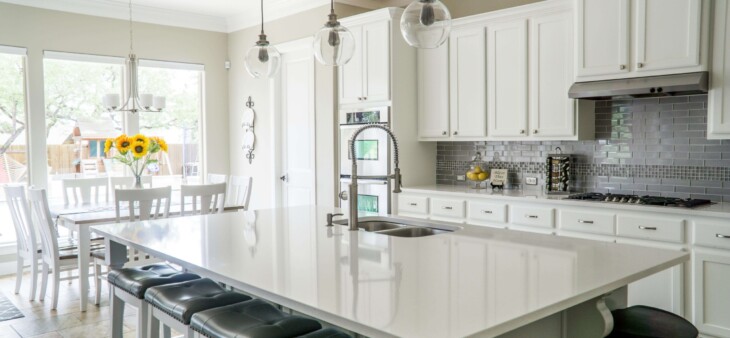Painting your kitchen cabinets is a significant project, but it can deliver impressive results, offering a beautiful and budget-friendly transformation. Cabinet painting allows you to take old, worn cabinets and refresh them with a new look, elevating the entire kitchen in the process.
If you’ve never painted kitchen cabinets before, the task might feel overwhelming. You may be wondering about the best approach and the potential challenges involved. To help you prepare, here are four key questions to ask yourself before starting, so you can decide whether to tackle it yourself or call in professional cabinet painters.
Question #1: How much time will it take to paint my kitchen cabinets?
While painting your kitchen cabinets is quicker and easier than a full cabinet replacement or major kitchen renovation, it still requires a significant time commitment. The more time you can dedicate, the better your results will be. Ask yourself if you have the time and patience for quality work. If you have a demanding job or small children, finding the time might be challenging. Depending on the number of cabinets, your skill level, and how much time you can spare each day, the project could take several days or even weeks to complete.
Additionally, your kitchen—and possibly your entire main living area—will be messy and potentially unusable during the process. Since the kitchen is the heart of your home, any renovation will impact your daily life and family routines. Are you prepared to live with the disruption until the cabinets are fully painted?
If time is a concern, the good news is that hiring professional cabinet painters is an affordable solution that delivers top-quality results. Professionals can complete the job much faster, reducing downtime and minimizing the inconvenience for you and your family.
Question #2: What materials are my cabinets made of?
You might not often consider what your cabinets are made of, but it plays a big role in how you approach painting them. Cabinets can be constructed from solid wood or engineered wood, like MDF, particleboard, or plywood with a wood veneer. Knowing the material beforehand is crucial for selecting the right products to ensure a smooth and durable finish.
Solid wood cabinets are the easiest to paint and typically produce the best results. For non-solid wood surfaces, however, paint doesn’t adhere as well, making peeling and chipping more likely—especially if proper prep work, like light sanding before priming, isn’t done. Using the correct paint products for your cabinet material is equally important.
The best strategy is to test a small, hidden area, such as the inside of a cabinet door, by sanding, priming, and painting it. Afterward, touch and wipe the sample frequently with a damp cloth to simulate daily use. If the paint begins to peel or chip, it might be time to consult a professional cabinet painter, who can ensure long-lasting results with the right techniques and products.
Question #3: Do I want the wood grain visible?
Many homeowners choose to paint their kitchen cabinets to cover up visible wood grain for a more modern, smooth finish. If your cabinets are stained or made from hardwood, consider whether you want to hide or highlight the wood grain. To completely cover it, you’ll need to thoroughly prepare the cabinets, use an opaque paint, and likely apply several coats to achieve full coverage.
If you prefer a natural wood look with the grain showing, a stain may be a better option than paint. The choice of product will depend on your cabinets’ current color and the look you want to achieve. Light-colored cabinets can be stained darker, but transforming already dark cabinets is more challenging.
If you have a specific vision in mind, consulting a professional painter is the best way to ensure you get the desired outcome. They’ll know the right techniques and products to use for achieving the perfect finish.
Question #4: Am I particular about details and small imperfections?
If you’re painting kitchen cabinets for the first time, mistakes are almost inevitable. Can you live with them? If you’re detail-oriented and want flawless results, hiring a professional painter may be your best option.
For example, if a drip mark would drive you crazy, it’s worth considering the benefits of professional help. Similarly, if you’re a perfectionist who might spend hours obsessing over a small imperfection, a DIY approach might not be the right fit.
Other Considerations When Painting Kitchen Cabinets
While painting kitchen cabinets can significantly transform the look and feel of your kitchen, it won’t resolve all your concerns. If you’re unhappy with the layout or door style of your cabinets, those issues will persist even after painting. For layout problems, a complete cabinet renovation may be the best solution to create a more functional configuration. If the door style doesn’t appeal to you, cabinet refacing can update the door fronts to a more modern aesthetic.
Also, keep your budget in mind. If you’re contemplating a full kitchen remodel but are worried about the costs, remember that painting kitchen cabinets is much more cost-effective than a full replacement. Cabinet painting typically costs a fraction of what new cabinets would. However, if you choose to tackle the project yourself and encounter mistakes, you’ll either have to live with them or hire a professional to fix them, which can ultimately lead to higher expenses. That’s why it’s often best to start with an experienced professional who has access to high-quality products and advanced equipment. This approach ensures less stress, a quicker turnaround, and cabinets that boast a beautiful, flawless finish.
Are you ready to learn more about painting your kitchen cabinets? N-Hance of NEPA is the trusted specialist in cabinet painting! Give us a call today for a FREE consultation and price quote!


